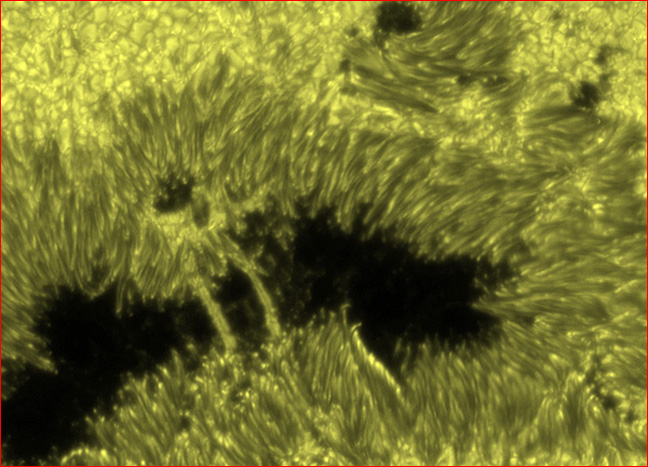
home •
about •
essential guide •
picture of the day •
thunderblogs •
news •
multimedia •
predictions •
products •
get involved •
contact
picture of the day archive subject index
Credit: Swedish Solar Observatory
Apr 14, 2006
Sunspots Still Surprise InvestigatorsAnomalous sunspot behavior continues to baffle solar physicists. Even the cause of sunspots remains elusive, and the more detailed pictures only seem to push the answers farther down the path.
“Exactly what happens and why these kind of structures are formed, we don't know “
Dan Kiselman, Royal Swedish Academy of Sciences, Stockholm.In the extreme close-up photograph of a sunspot above, we see the rope-like filaments of the penumbra, or margins of the sunspot. For many years solar physicists have claimed that these filaments were convection cells, typical of heated gases. But the higher-resolution details shown here, including the twin bridges across the sunspot, do not support traditional theory. All of the structure shown is consistent with the principle of anode tufting, a plasma discharge effect expected of a positively charged electric Sun.
High-resolution images of the penumbra filaments have revealed the distinctive characteristics of tornado-like charge vortices. By giving us a peek beneath the tops of the rotating discharge columns, sunspots enable us to view directly the columns’ explosive rise from below, as they heat and project plasma upward into the bright photospheric granules. For conventional theory, sunspot penumbrae remain a mystery: the standard solar model neither requires nor predicts such phenomena. In the electric model they are predictable. Electric discharges in plasma take the form of long, thin and twisting filaments. Because they are tornadic funnels of glowing plasma, they will appear darker in their centers, exactly as seen in the recent pictures. Convection cells would appear darker on their cooler peripheries.
The electric explanation of sunspots, like that of the penumbra, is rooted in the observed behavior of plasma discharge. In laboratory experiments, a torus forms above the equator of a positively charged sphere. Discharges then fly between the torus and the mid- to low-latitudes of the sphere. In the electric model, the Sun is the positively charged focal point of an electric field. And now we know that the Sun is indeed surrounded by an equatorial torus (as shown in the polar UV image here). Sunspots are the direct evidence that electric discharges punch holes in the photosphere to deliver current directly to lower depths, exposing a view of the cooler interior. Nothing ever observed on the Sun supports the idea of heat transfer from the core, where standard theory
places the nuclear fusion “furnace”. In the electric model, what nuclear fusion that does occur is located where the most energetic events occur, in the fierce electric tornadoes.In the laboratory experiments that produce the equatorial torus, the observed discharging to the positively charged sphere migrates latitudinally as the power input varies. The higher power produces maximum activity near the equator. The same thing occurs on the Sun in the latitudinal migration of sunspots in relation to the total energetic output of the Sun.
Standard theory will not allow that the cooler lower region revealed by sunspots means a cooler interior of the Sun. So astrophysicists have surmised that the sunspots are the result of focused magnetic fields interfering with heat transport, or convection. But they have confused electrical and magnetic effects. Investigation has shown that sunspots having the same magnetic polarity attract each other. But the poles of magnets repel. Electric currents, however (the source of magnetic fields), do attract each other, while maintaining their integrity through repulsion at extremely close distances. In fact, we see this effect when sunspots “merge”. Though conjoined, they retain their independent structure, just as currents do in plasma.
Standard models offer no coherent explanation for the approximate eleven-year sunspot cycle. There is no annual "clock" in an isolated thermonuclear explosion. Though a connection to the period of Jupiter is possible, perhaps even likely in terms of solar system circuitry, the remote gravitational effects of Jupiter on the Sun cannot compare to the energetic events associated with the sunspot cycle. In the electrical model the sunspot cycle is most likely a result a fluctuations in the electrical power supply from the local arm of our galaxy, the Milky Way, as the varying current density and magnetic fields of huge Birkeland current filaments slowly rotate past our solar system.
See: http://www.holoscience.com/news.php?article=s9ke93mf
__________________________________________________________________________Please visit our new "Thunderblog" page
Through the initiative of managing editor Dave Smith, we’ve begun the launch of a new
page called Thunderblog. Timely presentations of fact and opinion, with emphasis on
new discoveries and the explanatory power of the Electric Universe."The Electric Sky and The Electric Universe available now!

|
|

|
EXECUTIVE EDITORS:
David Talbott, Wallace Thornhill
MANAGING EDITOR:
Michael Armstrong
CONTRIBUTING EDITORS: Dwardu Cardona, Ev Cochrane,
C.J. Ransom, Don Scott, Rens van der Sluijs, Ian Tresman
WEBMASTER: Michael Armstrong
Copyright 2006: thunderbolts.info
![]()
home •
thunderblogs •
forum •
picture of the day •
resources •
team •
updates •
contact us

